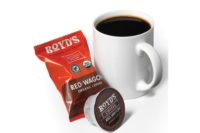The foodservice industry tends to be a leading indicator of how well the economy is going to perform, says Joe Pawlak, vice president of Chicago-based Technomic Inc. “When a recession is coming, typically foodservice sales will start dropping about six months before that, because it’s a discretionary purchase and one of the few things consumers will cut back on,” he explains. “Conversely, once we come out of a recession, foodservice is one of the few areas that comes back, where consumers are going to spend more because they have more discretionary dollars in their pockets. They may not be going back to buying houses or cars, but they’re spending whatever extra money they’re starting to get back in foodservice.”
Technomic reports that overall food and non-alcohol beverage sales in the foodservice industry reached more than $625 billion in 2013, achieving 3.8 percent nominal growth and 0.9 percent actual growth, according to its May 2013 data. This includes venues in schools; medical facilities; lodging, transportation and recreation areas; and military bases, as well as caterers; restaurants; and foodservice in supermarkets, convenience stores and other retailers. Technomic also predicts that this growth will continue into 2014 with 4.1 percent nominal growth and 1.1 percent actual growth.
More specifically, nominal restaurant sales rose 4.2 percent to $425.6 billion in 2012, according to the 23rd edition of the “Chain Restaurant Industry Review” by GE Capital, Franchise Finance (GEFF), Scottsdale, Ariz. Full-service restaurant sales increased 3.1 percent to $202.2 billion, while quick-service restaurant sales increased 5.6 percent to $179.3 billion, it reports. GEFF also projects that restaurant sales will increase 3.8 percent to $441.9 billion this year. This growth is a sign that U.S. consumers are more confident about their disposable income levels, it states.
Technomic’s Pawlak adds that consumer time constraints also are fueling channel growth. “People don’t have time to cook anymore at home,” he says. “They go out to eat, and even if they’re not eating at a restaurant, they’re taking out, taking it home, or taking it to lunch in their offices.”
In addition to this convenience factor, consumers expect value from foodservice venues, according to Chicago-based Mintel’s April 2013 report, “The Dining Out Experience – US.” In a November 2012 survey, Mintel found that 40 percent of consumers interviewed had taken advantage of value or dollar menu options in the last month, while 38 percent used coupons from newspapers, mailings and other advertisements, it reports.
Light vs. indulgent
Low-calorie menu options also are helping foodservice venues please consumers. According to Washington, D.C.-based Hudson Institute’s February 2013 report, “Lower-Calorie Foods,” chains that increased their lower-calorie food servings experienced increases in overall food servings while other chains recorded declines from 2006 to 2011. In line with this, the company also reported that within the 21 restaurant chains analyzed, including McDonald’s, Burger King, Wendy’s, Sonic, Panera Bread, Taco Bell, Applebee’s, Cracker Barrel, Chili’s, IHOP and Olive Garden, among others, lower-calorie beverage options, specifically those containing 50 or fewer calories in each 8-ounce serving, outperformed traditional beverages. In 2011, lower-calorie beverages captured 34.1 percent of total beverage sales in the channel with a 9.5 percent increase in servings, compared with a 1.6 percent increase for traditional beverage servings and a 4.1 percent increase for total beverage servings, the Hudson Institute reports, citing data from NPD Group, Port Washington, N.Y.
Low-calorie beverage options continue to pop up on foodservice menus this summer as well. Minneapolis-based Dairy Queen introduced its Orange Julius Light Smoothies as part of its national roll-out of Orange Julius Premium Fruit Smoothies and Julius Originals to its more than 4,000 Dairy Queen locations in the United States and Canada. Orange Julius Light Smoothies, which contain 170 calories or fewer in a small smoothie, are made with real fruit, do not contain any artificial flavors, and are available in Orange, Strawberry, Strawberry Banana, Tripleberry, Mango Pineapple, Berry-Pom, Orange Berry and Piña Colada varieties.
Similarly, Caribou Coffee Co. Inc., Minneapolis, added four “lite” sparkling teas and juices to its Caribou coffeehouse menus. The drinks contain half the amount of calories of Caribou’s original sparkling teas and juices, are made with real fruit and tea, and are available in Green Tea Lemonade, Peach Black Tea and Lemon Ginger Pomegranate varieties as well as a limited-time Apple Raspberry variety.
On the flipside of this trend, consumers also are using beverages from the foodservice channel to indulge themselves, Technomic’s Pawlak notes. “I think consumers are still indulging themselves in those types of beverages, whether they be coffee, specialty coffee beverages, or smoothies or frozen-fruit-type drinks,” he says. “There’s still a lot of growth in that area.”
Specialty coffee is growing very solidly, Pawlak says. “We’re seeing good growth there as more and more operators are getting involved and offering those products,” he explains. “Consumers no longer just think about coffee for breakfast; they think about it for a mid-afternoon snack or even as a dessert for dinner.”
This year, Miami-based Burger King refreshed its coffee platform with 10 new specialty blended coffee drinks featuring a new, 100-percent Latin American Arabica coffee bean custom blend brewed by Seattle-based Seattle’s Best Coffee, a wholly owned subsidiary of Starbucks Coffee Co. The new lineup includes Vanilla-, Mocha- and Caramel-flavored hot and iced coffees as well as Plain, Vanilla, Caramel and Mocha latte varieties.
For other indulgent options, Oak Brook, Ill.-based McDonald’s added a Dulche de Leche shake and a Blueberry Pomegranate smoothie to its McCafe menu for the summer. Inspired by a traditional Latin American dessert, the seasonal Dulche de Leche shake is made with McDonald’s Vanilla reduced-fat ice cream and caramel syrup and is topped with whipped cream and a cherry, the company says. The Blueberry Pomegranate smoothies, which start at 220 calories for a small size, are made with blueberries, raspberries, a splash of pomegranate juice and low-fat yogurt, it says.
Technomic’s Pawlak notes that specialty beverages, particularly smoothies, now are serving as snacks and meal substitutes, expanding these drinks’ usage occasions.
Complementary categories
As beverages for meal accompaniments, Pawlak notes that iced tea and bottled water are performing well in the foodservice segment as consumers move away from carbonated soft drinks, which have stabilized in recent years. Iced tea is doing especially well because of the value it offers foodservice operators, he says. “It’s very, very high in margin for the foodservice operator, so they’re more likely to push that item because they’re making money on it,” he explains.
Although Pawlak says that most of the iced tea growth is in traditional varieties — whether sweetened or unsweetened — Sonic is adding some more flavorful options to the mix. This year, the Oklahoma City-based franchise launched a line of freshly brewed sweet and diet green iced teas available in numerous flavor options, including its five newest sugar-free flavor mix-ins: Peach, Mango, Raspberry, Blackberry and Mint. “Because we are all about choices, we didn’t launch just one or two iced tea varieties but launched sweet and diet green iced tea with five new sugar-free flavor mix-ins,” said James O’Reilly, Sonic’s chief marketing officer, in a statement. “These new flavors, combined with our thousands of other iced tea flavor options, make it fun to make healthy choices.”
Crafting the perfect foodservice experience
According to Chicago-based Mintel’s April 2013 report, “The Dining Out Experience — US,” in order to increase brand loyalty and the likelihood that consumers will return again, restaurants need to create the right ambiance in order to generate a positive and memorable dining experience. In its surveys, Mintel found that, in general, consumers reported that cleanliness, menu selection and variety, and comfortable seating as the most important factors when creating a good atmosphere in a restaurant. Beyond these factors, consumer preferences about the ideal restaurant experience vary by demographic, Mintel found.
Women vs. men: Women place a much higher importance on cleanliness, menu variety and comfortable seating than their male counterparts, which shows that women have higher expectations of restaurants, according to Mintel. In addition, women place more importance on the reputation of a restaurant, while men find it more important that the staff at a given restaurant treats them like a friend or a regular, it reports.
When it comes to dining, women prefer not to feel rushed in their experience, are interested in healthy menu options, are attracted to special pricing, and appreciate the option to customize their meals, Mintel reports. Men, on the other hand, are comfortable serving themselves, prefer to be in and out as quickly as possible, and appreciate larger portions.
Seniors vs. millennials: Mintel found that, as consumers age, they place a higher value on cleanliness, menu selection, not feeling rushed, and the restaurant’s reputation. In addition, consumers aged 65 years and older are concerned with the noise level and lighting of a venue, it says. The market research firm suggests that restaurants ensure that lighting is bright enough so that consumers can read the menus and that the noise levels are low enough so that patrons can hear and participate in conversation in order to appease this demographic group. In addition, because of seniors’ dietary needs, smaller appetites and restricted incomes, Mintel suggests that restaurants offer heart-healthy, low-sodium, and high-fiber options as well as smaller portions with lower prices to accommodate these needs.
Consumers in the 18- to 24-year-old demographic group, on the other hand, reported that they like to visit certain restaurants because they reflect who they are as a person, Mintel reports. These consumers appreciate both venue and food customization in being able to select the ambient music and order their food the way they like it, the market research firm says. In addition, consumers in the 25- to 34-year-old demographic group tend to be interested in children’s programs at restaurants, as consumers in this age group tend to be starting families and dining with small children, it adds.
Hispanics vs. non-Hispanics
According to Mintel, Hispanics are more likely than non-Hispanics to place importance on a restaurant’s dress code, décor, music, and children’s programs. “While the dress code must be broad to meet the tastes of a restaurant’s core consumer group, décor, music and children’s programs can be tailored to specific parties,” Mintel states. To accommodate this, restaurants can make use of available technology including projection screens, accent lighting and tabletop stereos to adjust the ambiance as needed, Mintel suggests. It also suggests that restaurants create children’s activity booklets in Spanish for this consumer group. In addition, Mintel found that Hispanics are more likely than non-Hispanics to agree that self-service options and communal seating create an enjoyable dining experience, and they are more likely to be attracted to specific restaurants that offer coupons and special pricing.







